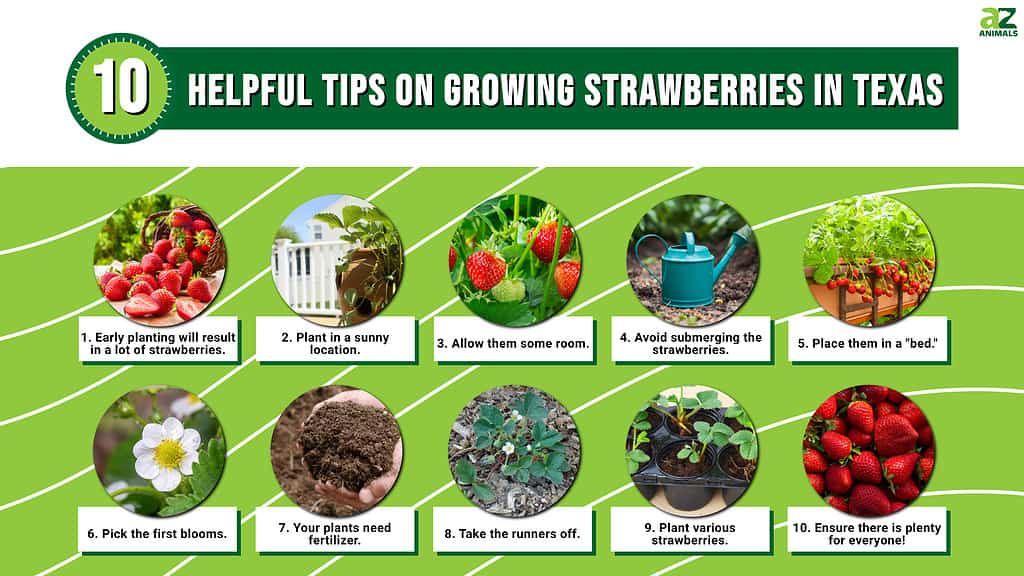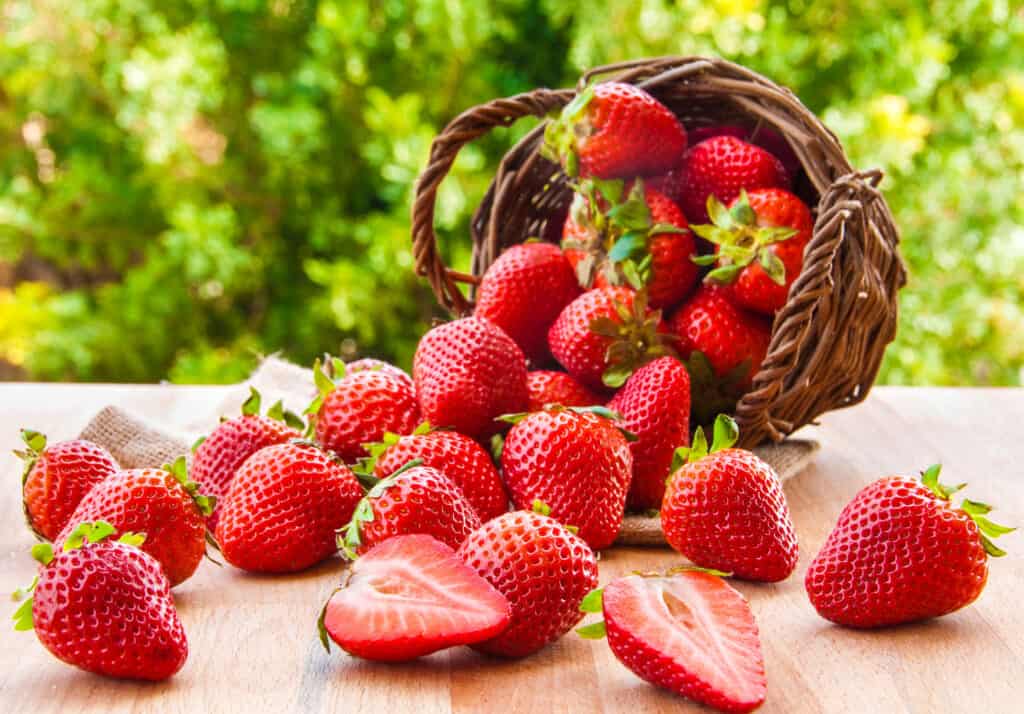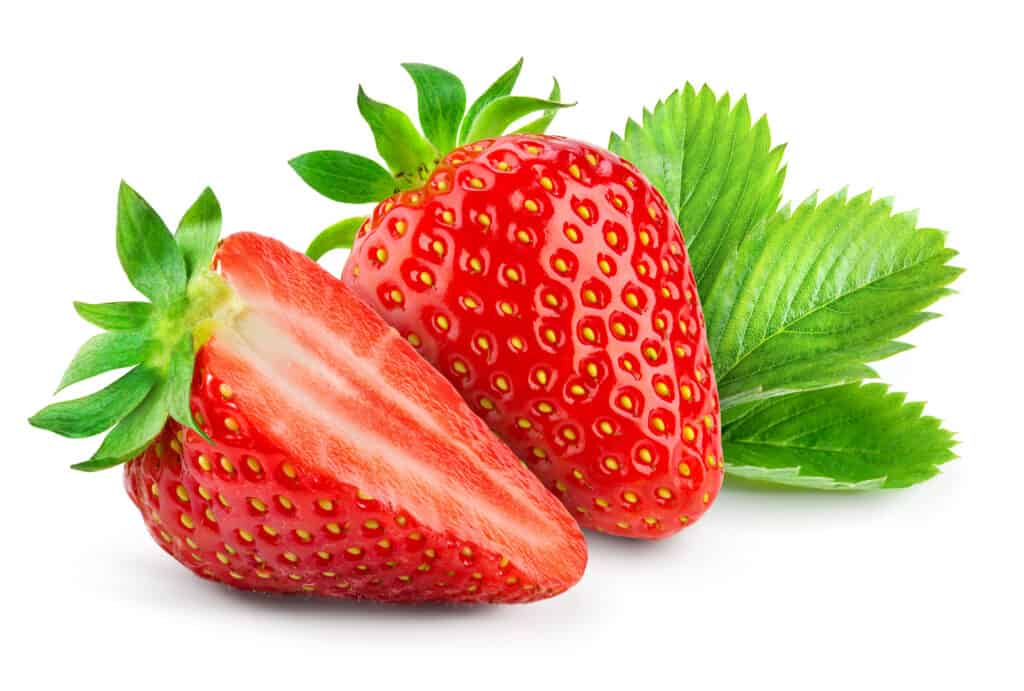
When you understand how to deal with the hot Texas weather, even the strawberry crop becomes bigger in Texas. Strawberry consumption is widespread in Texas and the rest of the country. When controlled effectively, strawberry production can provide significant income for growers. Experience has shown, nevertheless, that strawberries can be challenging to cultivate, particularly in West Texas’ semi-arid regions, the High Plains/Panhandle, and the Lower Rio Grande Valley.
This article discusses how you can grow strawberries in the heat of the Lone Star State and some helpful tips.
When is the Best Time to Plant Strawberries in Texas?

The best time to plant strawberries in Texas is from late January through mid-March.
©iStock.com/MariaUspenskaya
Strawberry planting season is in February, and the moderate spring climate in the Lone Star State is ideal for strawberries. Late January to mid-March is the best time to sow this low-spreading fruit. Strawberries can be sown as soon as six weeks before the last frost.
You can also plant June-bearing strawberries in late fall or early winter for a spring yield. The fruit will ripen in Texas through May if the weather stays cool, and ripening starts in February.
Meanwhile, you can plant strawberries in September in central and eastern Texas, including the Dallas-Fort Worth region; put off planting them in the hottest regions of south Texas until November. Strawberries are simple to grow and can produce fruit for many years.
Where is the Best Place to Plant Strawberries in Texas?

A rich location devoid of perennial weeds is a good place to plant strawberries in Texas.
©Tim UR/Shutterstock.com
Strawberries can be cultivated in various soil types as long as they receive at least eight hours of direct sunlight daily. Pick a sunny, rich location devoid of perennial weeds. Strawberries can grow on alkaline soils with a pH of 7.5 to 7.8. Plants in these soils may necessitate iron supplements due to iron shortage.
The area needs to be well-composted and well-drained. Additionally, you might want to work in some Texas green sand for more vitamins and minerals and expanded shale for moisture retention.
What Varieties of Strawberries Grow Best in Texas?

The cultivars Chandler, Camarosa, Festival, Seascape, Sequoia, and Douglas do best in Texas.
©Erika Anes/Shutterstock.com
Strawberry cultivars are classed according to how they respond to changes in day length during flowering. Flowering efficiency is categorized into three: short day (also known as “June bearing” or “spring bearing”), long day (also known as “everbearing”), and day-neutral.
In Texas’ hotter regions, spring-bearing strawberry cultivars ripen in February; in north Texas, they do not mature until June. The cultivars Chandler, Camarosa, Festival, Seascape, Sequoia, and Douglas are among those that do best in Texas. Texas gardeners should avoid everbearing and day-neutral strawberry cultivars since they thrive in cooler areas but struggle in Texas, particularly in the southern part of the state.
10 Helpful Tips on Growing Strawberries in Texas
1. Early planting will result in a lot of strawberries.
Although growing strawberries in June may seem like a pretty early time, the sooner you plant them, the more fruit you will get, and who doesn’t want more strawberries?
2. Plant in a sunny location.
Strawberries that are cultivated in a sunny area will have the best flavor. However, prevent plants from being immediately exposed to the sun. Instead, plant them early or late in the day.
3. Allow them some room.
Grant strawberries at least 10 inches of soil depth and at least 15 inches between each row of plants because they like breathing space.
4. Avoid submerging the strawberries.
Strawberries dislike being soaked in water. In these circumstances, they will rot quickly, so make sure your soil drains well. Small piles help keep the soil from getting too wet when planting strawberries.
5. Place them in a “bed.”
Raised beds are one of the best places to grow strawberries because you have environmental control. Elevated rows that help drainage and air ventilation are excellent for strawberry plant growth. Individual plants inside the rows should be spaced 12 inches apart. Position the plants so that their crowns are not submerged, but their roots are completely covered.
6. Pick the first blooms.
To encourage better growth, pick the first blossoms that appear on your strawberry plants. This is the perfect time to watch for any pests or insects while examining your strawberry plant for blooming.
7. Your plants need fertilizer.
When the plant starts to bloom, this is a critical time when it needs to focus its energy on developing healthy fruit. The most efficient fertilizer is one that is complete and high in potash.
8. Take the runners off.
Runners are strawberry plant offshoots. If the runners are left on a young strawberry plant, it will not fruit properly because they consume too much energy. Alternatively, you can leave runners on a fully grown plant if you want to plant more.
9. Plant various strawberries.
Having strawberry plants with various fruiting behaviors is a terrific idea because it will increase the size of your harvest window. Just before they ripen is the greatest time to gather them. If you leave them on the vine for too long, pests will have a better chance of getting to them first.
10. Ensure there is plenty for everyone!
Everyone likes strawberries, so planting about 5 plants per person is advised to ensure that there are enough for everyone. You’ll receive luscious berries all summer long if you do this.
Watering and Fertilization of Strawberries in Texas
A vulnerable host is a factor in the development of disease. Producers must control soil fertility by including necessary mineral sources rich in trace elements and micronutrients to maintain the health of their plants.
For the first two weeks following planting, water your strawberry plants daily to promote the transplants’ establishment. Winter watering should be less frequent, but it should still be sufficient to keep the soil constantly moist, especially in the east and south of Texas.
Another significant issue for growers of organic strawberries is weed management. Strawberries and many winter weed species thrive simultaneously, yet weed-controlling agents can harm strawberries.
Summary of 10 Helpful Tips on Growing Strawberries in Texas
| Rank | Tip |
|---|---|
| 1. | Early planting will result in a lot of strawberries. |
| 2. | Plant in a sunny location. |
| 3. | Allow them some room. |
| 4. | Avoid submerging the strawberries. |
| 5. | Place them in a “bed.” |
| 6. | Pick the first blooms. |
| 7. | Your plants need fertilizer. |
| 8. | Take the runners off. |
| 9. | Plant various strawberries. |
| 10. | Ensure there is plenty for everyone! |
The photo featured at the top of this post is © Erika Anes/Shutterstock.com
Sources
- Garden Guides, Available here: https://www.gardenguides.com/110507-plant-strawberries-texas.html
- Backyardanswer.com, Available here: https://backyardanswer.com/how-to-grow-strawberries-in-texas/
- Marshall Grain Co., Available here: https://www.marshallgrain.com/post/when-to-plant-strawberries
Thank you for reading! Have some feedback for us? Contact the AZ Animals editorial team.






